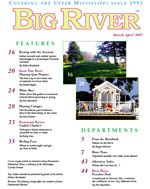|
March-April 2007 River News excerpts and Links to more information
Watching Eagles
Alma, Wis. - The turbulent waters below Lock and Dam 4 at Alma draw great numbers of hungry bald eagles - hundreds of them. Even in a harsh winter, 80 or more eagles hunt for fish and roost in trees nearby. The Wings Over Alma Nature and Art Center opened this winter at 118 Main St. to give visitors a better view of all this activity. The center displays local artists' works and provides an observation deck, complete with scopes and binoculars. It is also home to a visitor information center and gift shop.
La Crosse, Wis. - Downriver, the confluence of the Black and Mississippi Rivers also attracts both bald eagles and eagle watchers. Drivers who cross the rivers on Interstate 90 often slow down for eagle aerial displays, high-speed dives and fights on the ice.
Now the La Crosse Planning Department is seeking grants and approvals to turn the Highway 53 exit into a "vision corridor," complete with a parking pullout, a trail along the river and restaurants where visitors can dine when they tire of watching eagles eat.
Saving the Lone Star
LeClaire, Iowa - The last existing wooden-hulled paddlewheeler to ply the Mississippi will be protected and restored, thanks to $750,000 in grants, public donations and private gifts.
The Lone Star began hauling lumber on the river in 1869 and didnŐt retire until 1968. It is currently stored next to the Buffalo Bill Museum in LeClaire. Years of exposure have damaged the boat.
The surprise donation that capped phase one of the fundraising campaign came from a visitor from Tennessee who inquired about the museum's progress in raising funds, then sat down and wrote a check for $8,000, saying, "I had a pretty good year, and I just wanted to go and help the museum out."
After the wood and machinery on the 137-year-old, 90-ton boat are repaired, it will be mounted on a platform and enclosed in a glass house near the museum. (Argus-Dispatch, 1-4-07, Quad-City Times, 1-2-07)
Art for Nature
Minneapolis - Seventeen regional artists will show their work at the Bell Museum on the campus of the University of Minnesota, in a show called "Project Art for Nature," celebrating Wisconsin and Minnesota's wild places.
Working in teams of two or three, the artists visited a variety of sites several times to create 120 paintings, pastels, collages, fiber art, books and sculptures.
"Whether protected, in need of maintenance or restoration, or surviving through benign neglect, all the areas chosen by the artists provide diminishing habitat for precious native flora and fauna," said artist Vera Ming Wong. "We hope to offer the public an intimate view of what we all stand to lose, but hope to preserve."
Lend a Hand
Baraboo, Wis. - The Annual Midwest Crane Count, Saturday, April 14, from 5:30 to 7:30 a.m., needs volunteers in more than 100 counties in Wisconsin, Illinois, Iowa, Minnesota and Michigan.
Sandhill cranes have rebounded in the Midwest from a low of just 25 breeding pairs in 1932 to more than 13,000. The count was organized to measure how many have returned from their wintering grounds and where they are nesting.
For information, go to the International Crane Foundation, which sponsors the event.
Two months later, the river clean-up season will kick off with the Annual National River Cleanup Week from June 2 through 10. Sponsored by American Rivers, the event encourages people to organize new river cleanups and to volunteer at existing ones. Register online by April 15 for free trash bags and a chance to win canoes and kayaks.
For more information see National River Cleanup.
Cool Rocks & Fault
New Madrid, Mo. - Recent testing has disproved a theory about the New Madrid Seismic Zone, which centers on the central Mississippi River. The rocks under the zone are not hotter, as was theorized, and are "essentially no different from other sites in the eastern United States," said Jason R. McKenna, coauthor of a study undertaken by the U.S. Army Engineer Research and Development Center. In fact, there is evidence that the fault may be shutting down. Data showed no movement along the fault.
Huge earthquakes rocked the zone several times in the last 1,200 years: in 900 A.D.; 1450 A.D.; three big ones within a three-month period in 1811 and 1812; and another in 1968. The fault extends from northeast Arkansas through southeast Missouri, western Tennessee and western Kentucky to southern Illinois.
Researchers would like to know why earthquakes center here and when another big one might hit. The central river valley is much more populated now than it was in the early 1800s. (Science Daily, 12-29-06)
Refuge Cuts & Kudos
Winona, Minn. - Budget cuts will reduce personnel levels on the Upper Mississippi River National Wildlife and Fish Refuge and other refuges throughout the Midwest. Seventy-one positions will be eliminated through attrition or retirement in the next three years; 35 positions are already vacant and will not be filled.
Three refuges, Hamden Slough and Crane Meadows in central Minnesota, and Driftless Area in northeast Iowa, will lose all staff.
The agency's regional budget of $28.5 million a year has not increased since 2004. It manages more than 54 refuges, including Upper Miss, which gets more visitors than any other refuge in the United States.
Upper Miss Refuge manager Don Hultman will receive the 2007 Refuge Manager of the Year Award from the nonprofit National Wildlife Refuge Association, in March. Hultman, who is in charge of 11 refuges along 261 miles of the river, rode herd over a stormy four-year refuge planning process, finally producing the RefugeŐs Comprehensive Conservation Plan in August 2006.
| 


 Goat Prairies
Goat Prairies